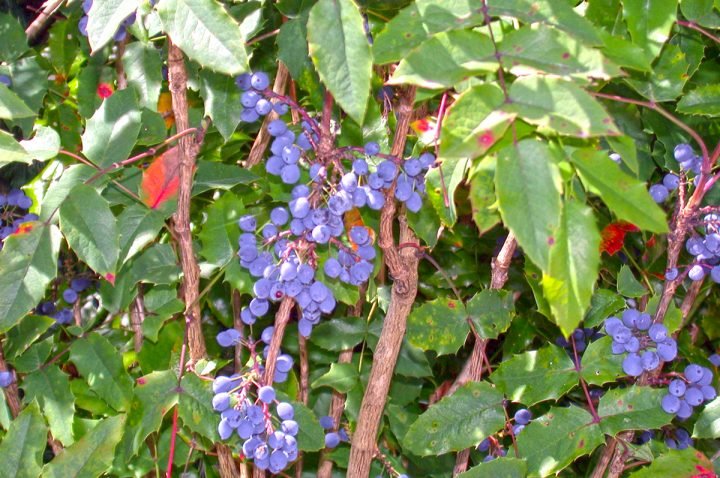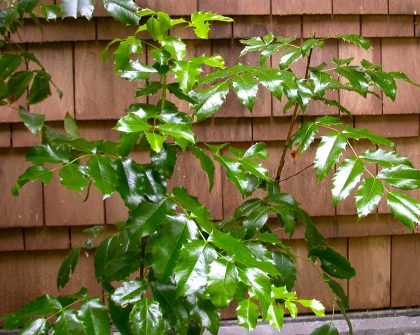
By Rhiannon Allen
Last September, I took a road trip to Osoyoos, British Columbia’s only desert, in the extreme south of the Okanagan region.
This was not my first visit, but it was my first opportunity to explore both the natural and cultivated flora of the region in an unconstrained manner. I spent days walking around the town and adjacent areas, and did thorough tours of the Desert Centre northwest of the town and the Nk’ Mip Desert Cultural Centre east of town.
Although there was no shortage of plants such as cacti and antelope bush that we never see here, as I wandered, I  noticed a number of plants that would be quite at home here in Point Roberts.
noticed a number of plants that would be quite at home here in Point Roberts.
I was actually surprised, since much of what I remembered from previous visits were plants novel to me. But how interesting to see familiar plants! I was particularly intrigued by what these plants offer to coastal gardeners. As Peg Keenleyside and I have pointed out in a number of columns, coastal gardeners have to adapt to dry summer gardening. Increased population and climate change are forcing us to reduce our use of summer water use. Well, what better promise for water-free summers than plants that weather both our winters and Osoyoos’s arid climate?
So what plants did I see in Osoyoos that are clearly adapted to our climate as well? One surprise was Mahonia (Oregon grape), named after Irish-American horticulturist McMahon. It grows wild both here and in Osoyoos. It’s also a respected and popular ornamental garden shrub, as an avid gardener friend who raved over the lushness of Lily Point’s wild Mahonia reminded me.
The type that suits itself best to landscape use is Mahonia aquifolium (tall Oregon grape). This is a tall, handsome shrub with shiny, evergreen holly-like leaves. Visitors to this year’s Point Roberts Garden Tour saw a wall of it standing proud at the entrance to one garden.
In addition to its landscape and garden functions, all parts of this plant can be used in one form or another. In spring, it sports clusters of cheery yellow flowers. Did you know that these flowers are edible? They have a tart, lemony flavor that refreshes the mouth better than chewing gum. You might have to compete with the bees to give it a try, however.
Mahonia is one of the first plants to bloom in the calendar year, and the early mason bees and bumblebees are ravenous for its nectar. These flowers change and mature into dark purple berries that can be harvested in late June or early July. First Nations people traditionally use the berries raw, cooked and dried. Many people like to make jam or wine from the berries. I prefer to eat the berries raw, but some people find them too sour.
My father also showed me how the inner bark of Mahonia is intensely yellow. It didn’t come as a surprise, then, when in a dyeing class at the University of British Columbia we used the roots and bark to make yellow and orange natural fabric dyes. Even the leaves are useful, if you don’t mind the prickliness. The mature leaves look terrific in floral displays, and they don’t wilt. I’ve even read that the young leaves can be made into a medicinal tea, but I am loathe to try that myself.
Does it have any disadvantages? Well, it can grow up to 10 feet tall and can sucker, although not aggressively in most situations. That means it will spread slowly by underground roots. Given that the leaves are so prickly, then, it makes sense to locate the plant where it has room to grow and where it won’t impede your passage. Otherwise, you will find yourself having to prune it back.
Second, I’ve found that it grows best with good air circulation. While cultivation guides suggest that it can be grown under trees, I’ve noticed that Mahonia aquifolium can get leggy, mildewed and infested with whitefly if planted in a dark, dry, stuffy part of your garden.
Have I gotten you excited about acquiring this attractive, useful native plant? Are you looking forward to a summer free of watering, followed by enjoying the handsome glossy foliage that sticks around all winter? Well, hold your horses! Don’t try buying it in Canada to bring back into Point Roberts.
Unfortunately, it is a host to black stem rust. Since Canadian plant health inspectors do not have a black stem rust certification program, they cannot certify Mahonia as being rust-free for import. So your only resource is buy the plant locally or from a reputable online American plant retailer who will ship the plant to you by bonded carrier.
Happy water-wise gardening!
Thanks to Kara Soares of the Canadian Food Inspection Agency for explaining the prohibition on Mahonia import.
Comments
No comments on this item Please log in to comment by clicking here